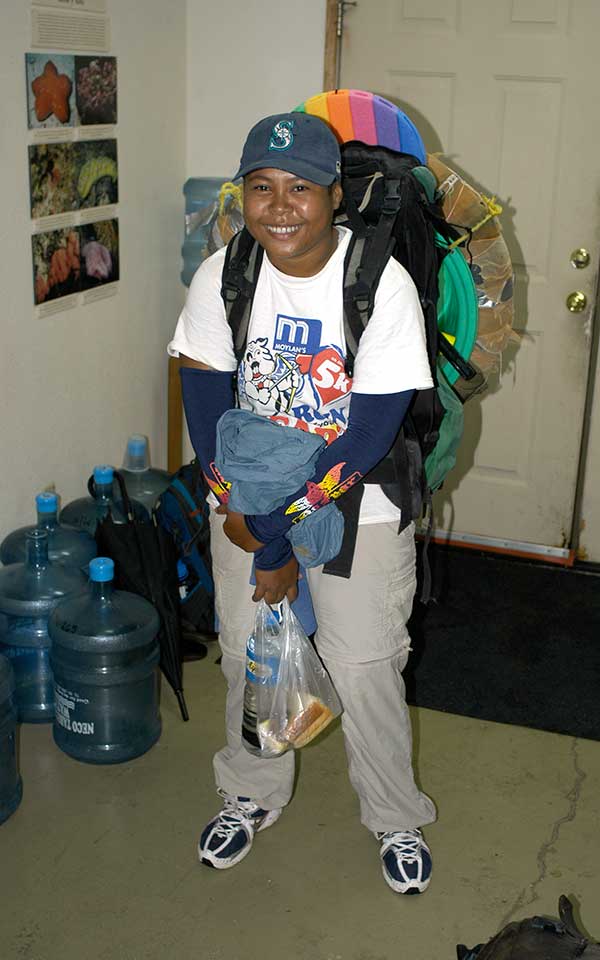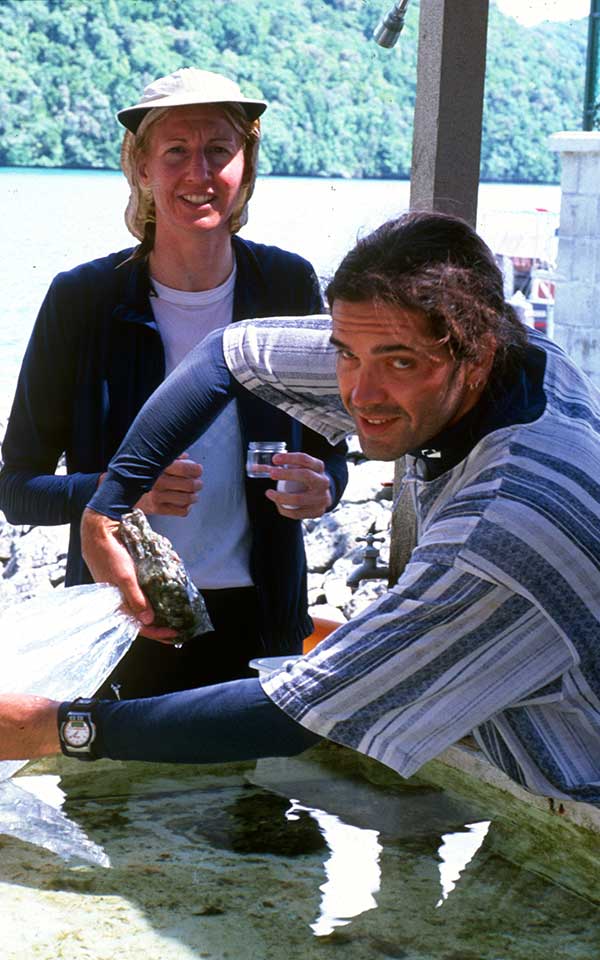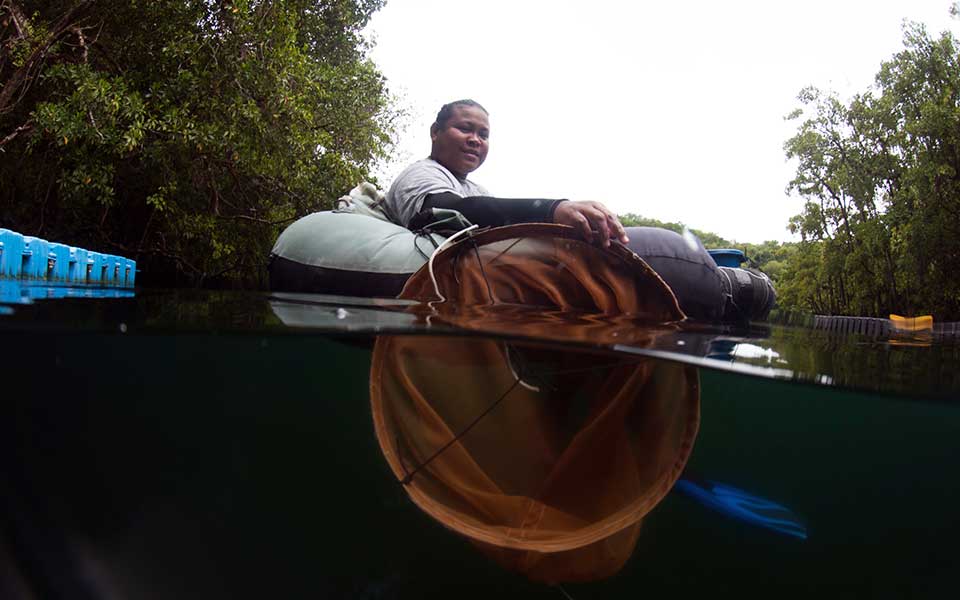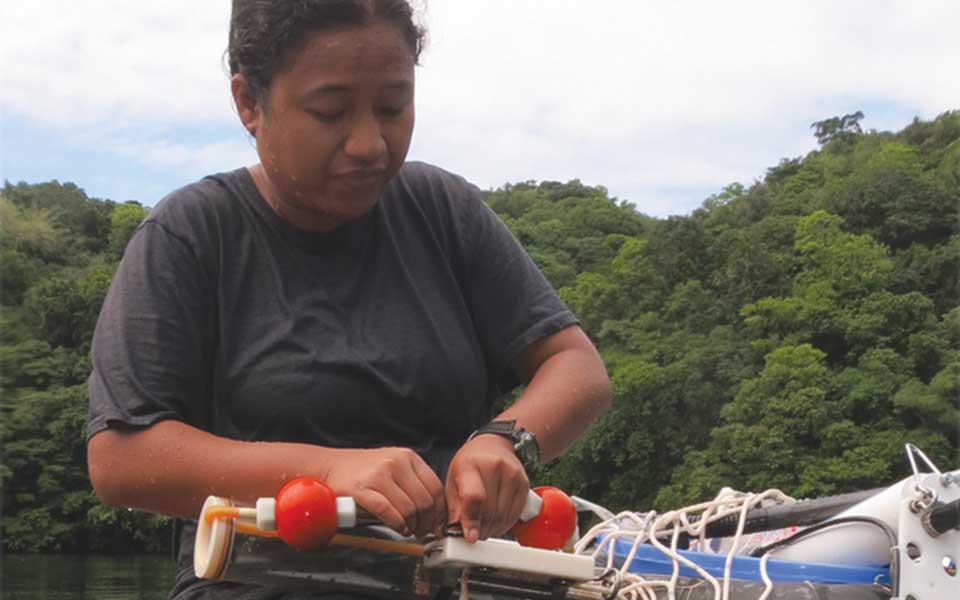Abromeit, L and C. Gerigk. 2009. Der Schwarm von Palau. GEO (5 May 2009): 24-52.
Bates, A.L., E,C. Spiker, and W.H. Orem. 1993. Speciation and isotopic composition of sulfur in sediments from Jellyfish Lake, Palau. Chem. Geol. 106:63-76.
Bergquist, P.R. and M. Kelly. 2004. Taxonomy of some Halisarcida and Homoscleromorphida (Porifera:Demospongiae) from the Indo-Pacific. N.Z. J. Mar. Freshwater Res. 38:51-66.
Burnett, W.C., W.M. Landing, Lyons, W.B., and W. Orem. 1989. Jellyfish Lake, Palau: A model anoxic environment for geochemical studies. Eos. 15 Aug. 1989: 777-783.
Cimino, M.A., Patris, S., Ucharm, G., Bell, L.J. and Terrill, E., 2018. Jellyfish distribution and abundance in relation to the physical habitat of Jellyfish Lake, Palau. Journal of Tropical Ecology, 34(1), pp.17-31.
Dawson, M.N. 2000. Variegated mesocosms as alternativies to shore-based planktonkreisels: notes on the husbandry of jellyfish from marine lakes. J Plankton Res. 22(9):1673-1682.
Dawson, M.N. 2003. Macro-morphological variation among cryptic species of the moon jellyfish Aurelia (Cnidaria: Scyphozoa). Mar. Bio. 143:369-379. Erratum Mar. Bio. 144:203.
Dawson, M.N 2005a. Morphological variation and systematics in the Scyphozoa: Mastigias (Rhizostomeae, Mastigiidae) – a golden unstandard? Hydrobiologia 537:185-206.
Dawson, M.N 2005b. Five new subspecies of Mastigias (Scyphozoa: Rhizostomeae: Mastigiidae) from marine lakes, Palau, Micronesia. J. Mar. Biol. Ass. U.K. 85:679-694.
Dawson, M.N 2006. Island Evolution in Marine Lakes. JMBA Global Marine Environment 3:26-29.
Dawson, M.N 2016. Islands and island-like marine environments. Global Ecology & Biogeography 25:831–846. doi: 10.1111/geb.12314.
Dawson, M.N, A.C. Algar, L.R. Heaney, & Y.E. Stuart. 2016. The evolutionary biogeography of islands, lakes, and mountaintops. Pp. 203–210 in The Encyclopedia of Evolutionary Biology v.I (R.M. Kliman, ed). Academic Press, Oxford.
Dawson, M.N. and W.M. Hamner. 2003. Geographic variation and behavioral evolution in marine plankton: the case of Mastigias (Scyphozoa, Rhizostomeae). 143:1161-1173.
Dawson, M.N and W.M. Hamner. 2005. Rapid evolutionary radiation of marine zooplankton in peripheral environments. Proc. Natl. Acad. Sci. 102:9235-9240.
Dawson, M.N. and D.K. Jacobs. 2001. Molecular evidence for cryptic species of Aurelia aurita (Cnidaria, Scyphozoa). Biol. Bull. 200:92-96.
Dawson, M.N. and L.E. Martin. 2001. Geographic variation and ecological adaptation in Aurelia (Scyphozoa, Semaeostomeae): some implications from molecular phylogenetics. Hydrobiologia 451:259-273.
Dawson, M.N., L.E. Martin and L.K. Penland. 2001. Jellyfish swarms, tourists, and the Christ-child. 2001. Hydrobiologia 451:131-144.
Dierssen, H., W. Balzer and W.M. Landing. 2001. Simplified synthesis of an 8-hydroxyquinoline chelating resin and a study of trace metal profiles from Jellyfish Lake, Palau. Mar. Chem. 73:173-192.
Fabricius, K.E., J.C. Mieog, P.L. Colin, D. Idip and M.J.H. Van Oppen. 2004. Identity and diversity of coral endosymbionts (zooxanthellae) from three Palauan reefs with contrasting bleaching, temperature and shading histories. Mol. Ecol. 13:2445-2458.
Faulkner, Douglas. 1974. This Living Reef. Quadrangle/The New York Times Book Co., New York. 183pp.
Fautin, D.G. and W.K. Fitt. 1991. A jellyfish-eating sea anemone (Cnidaria, Actiniaria) from Palau: Entacmaea medusivora sp. nov. Hydrobiologia 216/217:453-461.
Ghiselin, M.T. and J.H. Lipps. 2019. The sea slug Phanerophthalmus luteus (Gastropoda: Opistobranchia) and its habitat and ecology at the marine Jellyfish Lake (Ongeim’l Tketau), Palau, western Pacific ocean. Proc. Cal. Acad. Sci. 64(8):181-194.
Gotoh, R.O., H. Sekimoto, S.N. Chiba and N. Hanzawa. 2009. Peripatric differentiation among adjacent marine lake and lagoon populations of a coastal fish, Sphaeramia orbicularis (Apogonidae, Perciformes, Teleostei). Genes Genet. Syst. 84:287-295.
Hamner, W.M. 1982. Strange world of Palau’s salt lakes. Nat. Geogr. 161(2):264-282.
Hamner, W.M., R.W. Gilmer and P.P. Hamner. 1982. The physical, chemical and biological characteristics of a stratified, saline, sulfide lake in Palau. Limnol. Oceanogr., 27(5):896-909.
Hamner, W.M. and P.P. Hamner. 1998. Stratified marine lakes of Palau (Western Caroline Islands). Physical Geogr. 19(3):175-220.
Hamner, W.M. and I.R. Hauri. 1981. Long-distance horizontal migrations of zooplankton (Scyphomedusae: Mastigias). Limnol. Oceanogr. 26(3):414-423.
Hanzawa, N., R.O. Gotoh, H. Sekimoto, T.V. Goto, S.N. Chiba, K. Kuriiwa and H.B. Tamate. 2012. Genetic Diversity and Evolution of Marine Animals Isolated in Marine Lakes. Pp. 121-150 in Analysis of Genetic Variation in Animals (M. Caliskan, ed.) InTech, www.intechopen.com.
Katija, K. and J.O. Dabiri. 2009. A viscosity-enhanced mechanism for biogenic ocean mixing. Nature 460:624-626.
Kawagata, S., M. Yamasaki and R.W. Jordan. 2005a. Acarotrochus lobulatus, a new genus and species of shallow-water benthic foraminifera from Mecherchar Jellyfish Lake, Palau, NW equatorial Pacific ocean. J. Foram. Res. 35(1):44-49.
Kawagata, S., M. Yamasaki, R. Genka and R.W. Jordan. 2005b. Shallow-water benthic foraminifers from Mecherchar Jellyfish Lake (Ongerul Tketau Uet), Palau. Micronesica 37(2):215–233.
Kelly, M. and L.J. Bell. 2016. Splendid Sponges of Palau with additional design by Blayne Herr. NIWA/Coral Reef Research Foundation, 70 pp.
Ladd, S.N. and J.P. Sachs. 2015. Influence of salinity on hydrogen isotope fractionation in Rhizophora mangroves from Micronesia.” Geochimica et Cosmochimica Acta 168, 206-221, DOI:10.1016/j.gca.2015.07.004
Ladd, S.N. and J.P. Sachs. 2017. 2H/1H fractionation in lipids of the mangrove Bruguiera gymnorhiza increases with salinity in the marine lakes of Palau. Geochimica et Cosmochimica Acta. doi:10.1016/j.gca.2017.01.046
Landing, W.M., W.C. Burnett, B. Lyons, and W.H. Orem, 1991. Nutrient cycling and the biogeochemistry of manganese, iron, and zinc in Jellyfish Lake, Palau. Limnol. Oceanogr. 36(3):515-525.
Lipps, J.H. and M.R. Langer. 1999. Benthic foraminifera from the meromictic Mecherchar Jellyfish Lake, Palau (western Pacific). Micropaleontology 45(3):278-284.
Lobban, C.S. and M. Schefter. 1997. Tropical Pacific Island Environments. University of Guam Press, Mangilao, Guam. 399pp.
Lobban, C.S., M. Schefter, F. Camacho and J. Jocson. 2014. Tropical Pacific Island Environments. 2nd Ed. Bess Press, Honolulu. 530pp.
Lyons, W.B., R.M. Lent, W.C. Burnett, P. Chin, W.M. Landing, W.H. Orem, and J.M. McArthur. 1996. Jellyfish Lake, Palau: regeneration of C, N, Si, and P in anoxic marine sediments. Limnol. Oceanogr. 41(7): 1394-1403.
Martin, L.E. 1999. Population Biology and Ecology Aurelia sp.(Scyphozoa: Semaeostomeae) in a Tropical Meromictic Marine Lake in Palau, Micronesia, PhD disssertation, UCLA, 250pp.
Martin, L.E. 2001. Limitations on the use of impermeable mesocosms for ecological experiments involving Aurelia sp. (Scyphozoa: Seamaeostomeae). J. Plankton Res. 23:1-10.
Martin, L.E., M.N Dawson, L.J. Bell and P.L. Colin. 2005. Marine lake ecosystem dynamics illustrate ENSO variation in the tropical western Pacific. Biol. Lett. doi:10.1098/rsbl.2005.0382.
McCloskey, L. Muscatine and F.P. Wilkerson. 1994. Daily photosynthesis, respiration and carbon budgets in a tropical marine jellyfish (Mastigias sp.) Mar. Bio. 119:13-22.
McGee, T. 2017. Palau Rainfall Changes over the Last 9,000 Years. MSc Thesis, Univ of Washington, School of Oceanography, pp. 33.
Meyerhof, M.S., K.M. Henry, J.M. Wilson, M.N Dawson & J.M. Beman. 2016. Microbial community diversity, structure, diversity, and assembly across oxygen gradients in meromictic marine lakes, Palau. Environmental Microbiology doi: 10.1111/1462-2920.13416
Monniot, F. and C. Monniot. 1996. New collections of ascidians from the eastern Pacific and southeastern Asia. Micronesica 9(2): 133-279.
Monniot, F. and C. Monniot. 2001. Ascidians from the tropical western Pacific. Zoosystema 23(2):201-383.
Monniot, F. and C. Monniot. 2008. Complements sur la diversite des ascidies (Ascidiaces, Tunicata) de l’ouest Pacifique tropical. Zoosystema 30(4):799-872.
Muscatine, L. and R.E. Marian. 1982. Dissolved inorganic nitrogen flux in symbiotic and nonsymbiotic medusae. Limnol. Oceanogr. 27(5):910-917.
Muscatine, L., F.P. Wilkerson and I.R. McCloskey. 1986. Regulaton of population density of symbiotic algae in a tropical marine jellyfish (Mastigias sp.). Mar. Ecol. Prog. Ser. 32:279-290.
Meyerhof, M.S., Wilson, J.M., Dawson, M.N. and Michael Beman, J., 2016. Microbial community diversity, structure and assembly across oxygen gradients in meromictic marine lakes, Palau. Environmental microbiology, 18(12), pp.4907-4919.
Orem, W.H., W.C. Burnett, W.M. Landing, W.B. Lyons, and W. Showers. 1991. Jellyfish Lake, Palau: Early diagenisis of organic matter in sediments of an anoxic marine lake. Limnol. Oceanogr. 36(3): 526-543.
Patris, S. 2015. The expansion and impact on native species of a sea anemone introduced into a tropical marine lake (Jellyfish Lake, Palau). MSc Thesis, Univ. Calif. Merced, Quantitative and Systems Biology, pp. 1-23.
Patris, S.W., L.E. Martin, L.J. Bell & M.N Dawson. 2019. Expansion of an introduced sea anemone population, and its associations with native species in a tropical marine lake (Jellyfish Lake, Palau). Frontiers of Biogeog. DOI:10.21425/F5FBG41048.
Patris, S, M.N Dawson, L.J. Bell, L.E. Martin and P.L. Colin. 2010. Jellyfish Lake (Ongeim’l Tketau). Coral Reef Research Foundation. 14 pp.
Patris, S.W., M.N Dawson, L.J. Bell, L.E. Martin, P.L. Colin, & G. Ucharm, with additional design & images by M. Etpison, 2012. Ongeim’l Tketau. Coral Reef Research Foundation/Etpison Museum, 44 pp.
Richey, J.N. & J.P. Sachs. 2016. Precipitation changes over the western tropical Pacific over the past millennium. Geology 44:617–674. doi:10.1130/G37822.1.
Rocha de Souza, M. and M.N Dawson. 2018. Redescription of Mastigias papua (Scyphozoa, Rhizosotomeae) with designation of a neotype and recognition of two additional species. Zootaxa. 4457 (4): 520–536.
Sachs, J.P., D. Sachse, R.H. Smittenberg, Z. Zhang, D.S. Battisti and S. Golubic. 2009. Southward movement of the Pacific intertropical convergence zone AD 1400-1850. Nature Geoscience 2:519-525.
Saitoh, S., H. Suzuki, N. Hanazawa and H. Tamate. 2011. Species diversity and community structure of pelagic copepods in the marine lakes of Palau. Hydrobiologia 666:85-97.
Smittenberg, R.H., C. Saenger, M.N Dawson and J.P. Sachs. 2011. Compound-specific D/H ratios of the marine lakes of Palau as proxies for West Pacific Warm Pool hydrologic variability. Quaternary Sci. Reviews 30:921-933.
Swift, H.F. 2016. The ecological and evolutionary effects of environmental perturbations on populations and communities. PhD Thesis, Univ. Calif. Merced, Quantitative and Systems Biology, pp. 1-142.
Swift, H.F., L.E. Gómez Daglio, & M.N Dawson. 2016. Three routes to crypsis: stasis, convergence, and parallelism in the Mastigias species complex (Scyphozoa, Rhizostomeae). Molecular Phylogenetics and Evolution 99:103–115. doi:10.1016/j.ympev.2016.02.013
Turner, P.S. 2006. Darwin’s Jellyfishes. National Wildlife 44(5):32R-32X.
Wilson, J.M. 2017. Controls on Marine Community Respiration. PhD Thesis, Univ. Calif. Merced, Environmental Systems, pp. 1-110.
Wilson, J., S. Abboud and J.M. Beman. 2017. Primary Production, Community Respiration, and Net Community Production along Oxygen and Nutrient Gradients: Environmental Controls and Biogeochemical Feedbacks within and across “Marine Lakes,” Front. Mar. Sci., doi.org/10.3389/fmars.2017.00012.
Venkateswaran, K., A. Shimada, A Maruyama, T. Higashihara and T. Maruyama. 1993. Microbial characteristics of Palau Jellyfish Lake. Can. J. Microbiol. 39:5506-512.
























